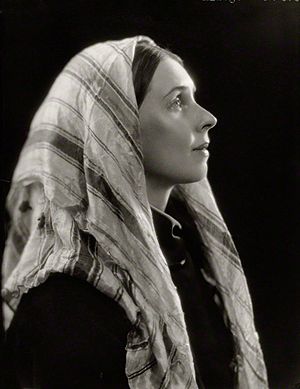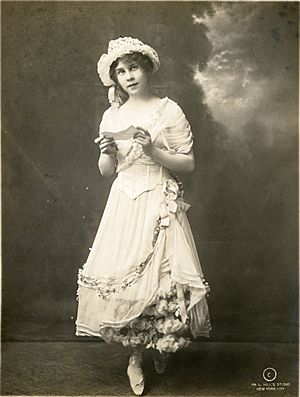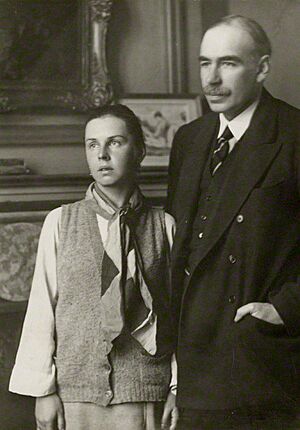Lydia Lopokova facts for kids
Quick facts for kids
The Lady Keynes
|
|
|---|---|

Lydia Lopokova in 1922
|
|
| Born |
Lidia Vasilyevna Lopukhova
21 October 1891 |
| Died | 8 June 1981 (aged 89) Seaford, East Sussex, England
|
| Occupation | Ballerina |
| Title | Lady Keynes |
| Spouse(s) | |
| Relatives | Fyodor Lopukhov (brother) |
Lydia Lopokova (born Lidia Vasilyevna Lopukhova) was a famous Russian ballerina in the early 1900s. She trained at the Imperial Ballet School and danced with the famous Ballets Russes company.
Lydia married the well-known English economist John Maynard Keynes in 1925. She was also known as the Lady Keynes. After his death in 1946, she lived a quieter life in Sussex, England.
Contents
Early Life and Training
Lydia Lopokova was born in Saint Petersburg, Russia. Her father worked at the Alexandrinsky Theatre. Four of her siblings became ballet dancers. Her brother, Fyodor Lopukhov, became a chief choreographer for the Mariinsky Theatre.
Lydia trained at the Imperial Ballet School. She quickly became a star student. As a child, she danced for the Emperor and his family. She also saw the events of Bloody Sunday in 1905.
As she grew older, Lydia was drawn to the new style of dance by Mikhail Fokine. This style was different from the older, stricter ballet. Her chance came when she joined the Ballets Russes for their European tour in 1910. The director, Sergei Diaghilev, even made her a year younger to promote her as a child star. She stayed with the Ballets Russes for a short time.
Dancing in America and Europe
Lydia received a very good offer from America. She was offered 18,000 francs per month, which was much more than she earned in Russia. After a summer tour, she moved to the United States. She stayed there for five years and was very successful. In 1914, she legally changed her name to Lopokova.
In 1915, while in New York, she got engaged to a sportswriter named Heywood Broun. When the Ballets Russes came to the United States in 1916, she ended her engagement. Soon after, she married the company's business manager, Randolfo Barrocchi. She danced regularly with the company, including with her former partner, Vaslav Nijinsky.
She toured with the Ballets Russes in America, Europe, and South America. She also danced in London. People in London first noticed her in The Good-humoured Ladies in 1918. Later, she gave a lively performance in the Can-Can of La Boutique fantasque. Her marriage to Barrocchi ended in 1919. She also had an on-off relationship with Igor Stravinsky, who wrote music for the Ballets Russes.
Marriage to John Maynard Keynes
In 1921, the Ballets Russes put on a big show of The Sleeping Beauty. Lydia danced as the Lilac Fairy and Princess Aurora. The show was not a big success, but it caught the eye of John Maynard Keynes. He watched her every night and was charmed by her.
Lydia and Keynes soon became a couple. They married in 1925 after her divorce was finalized. Before Lydia, Keynes's closest friends were from the Bloomsbury group. Some of these friends, like Virginia Woolf, found Lydia hard to accept at first. They were not happy about her marriage to Keynes for many years. However, some of them later changed their minds. For example, E.M. Forster wrote that they had underestimated her.
Lydia became friends with many other important people in London's art world. These included T. S. Eliot and H.G. Wells. During these years, she also became friends with Pablo Picasso, who drew her many times. Lydia and Keynes hoped to have children, but it did not happen.
The couple spent their honeymoon in Sussex in 1925. The philosopher Ludwig Wittgenstein visited them briefly. Lydia once said to Wittgenstein, "What a beautiful tree." Wittgenstein asked, "What do you mean?" which made Lydia cry.
Later Life and Contributions
Lydia Lopokova was involved in the early days of English ballet. She also performed on stage in London and Cambridge starting in 1928. She was on the BBC as a presenter and an actress. In 1935, she read "The Red Shoes" on the BBC. She later read it again for BBC television.
Lydia is shown as Terpsichore, the muse of dancing, in a mosaic at the National Gallery in London. This mosaic was made by Boris Anrep in 1933. Also in 1933, she danced her last ballet role. She played Swanhilda in Coppélia for the new Vic-Wells Ballet.
She lived with Keynes in London, Cambridge, and Sussex. Lydia was Keynes's partner in starting the Cambridge Arts Theatre. She also helped him with ideas for the Arts Council. With his help, she became a key person in the Camargo Society. This society helped create a national ballet company.
After her husband became ill in 1937, Lydia spent more time taking care of him. She made sure he ate well and rested enough. Her constant care and cheerful spirit helped Keynes stay strong. Without her, he might not have been able to attend important meetings like Bretton Woods.
Death
After Keynes died in 1946, Lydia largely stopped appearing in public. She lived in Tilton House, Sussex, for the rest of her life. She died in a nursing home in Seaford in 1981, at 89 years old.
Cultural Representations
Virginia Woolf based the character of Rezia in her novel Mrs Dalloway partly on Lydia.
Lynn Seymour played Lydia in the 1993 film Wittgenstein, directed by Derek Jarman.
Wooing in Absence was a performance by Natalia Makarova and Benjamin Whitrow. It was directed by Patrick Garland.
The novel Mr Keynes' Revolution (2020) by E. J. Barnes is about the lives of Keynes and Lopokova in the 1920s.
Love Letters was a performance with Helena Bonham Carter as Lopokova and Tobias Menzies as Keynes. It was performed in July 2021.
Biographies
Maynard Keynes's nephew Milo Keynes wrote a biography called Lydia Lopokova (1983, ISBN: 0312500394). Judith Mackrell published her biography, Bloomsbury Ballerina: Lydia Lopokova, Imperial Dancer and Mrs John Maynard Keynes, in 2008 (ISBN: 0297849085).
See also
 In Spanish: Lidia Lopujova para niños
In Spanish: Lidia Lopujova para niños
- Keynes family
- List of Russian ballet dancers



